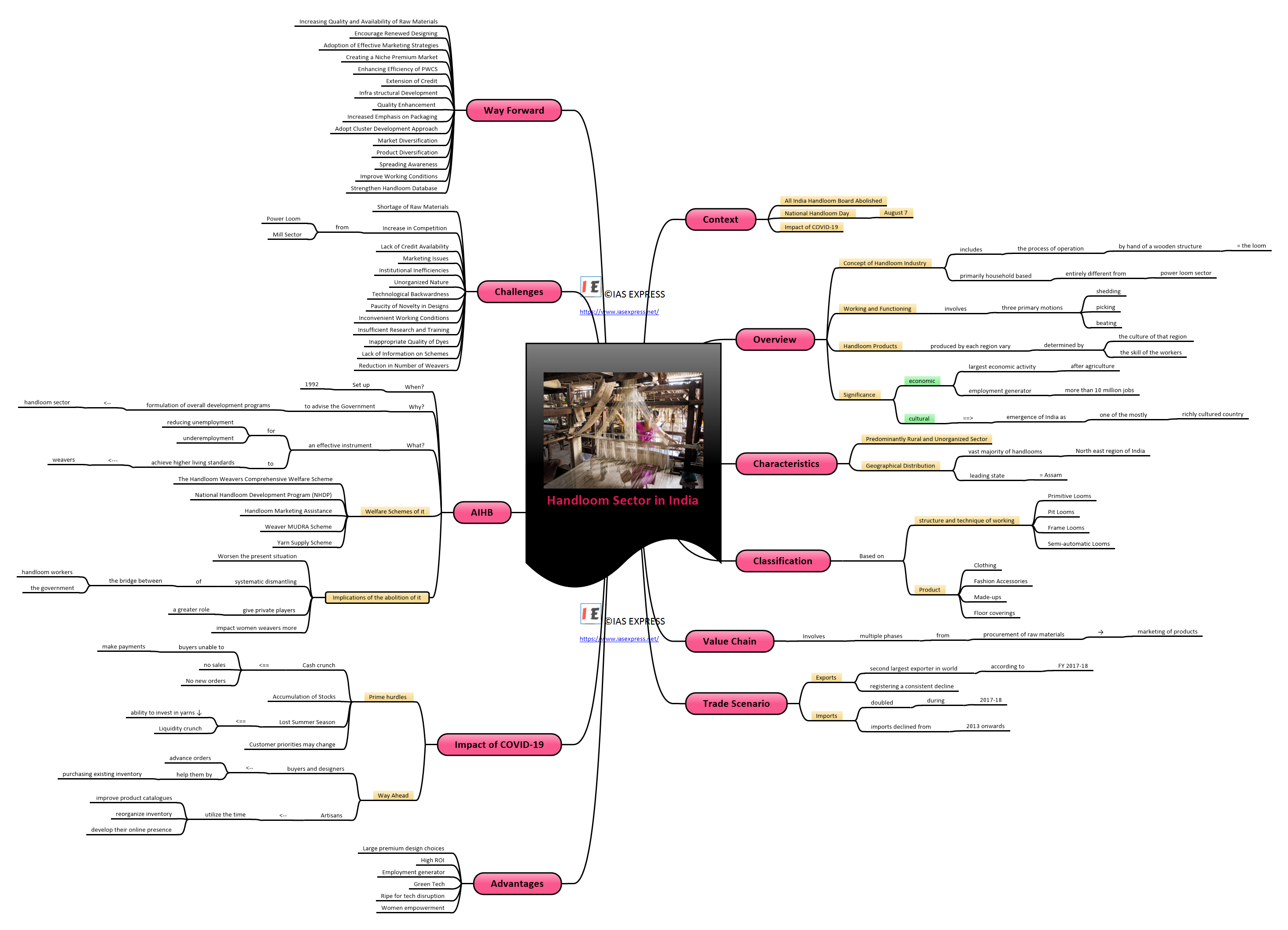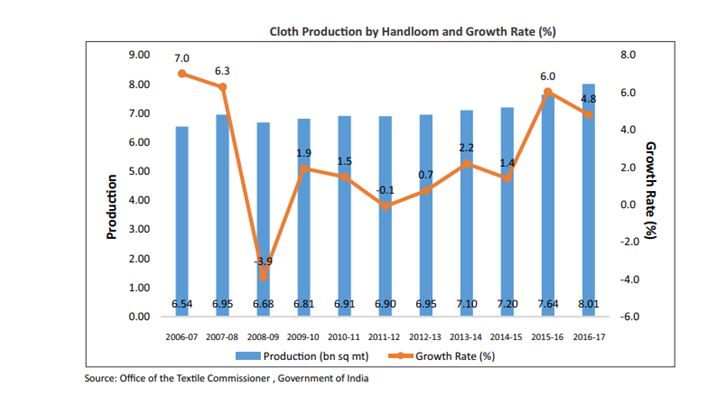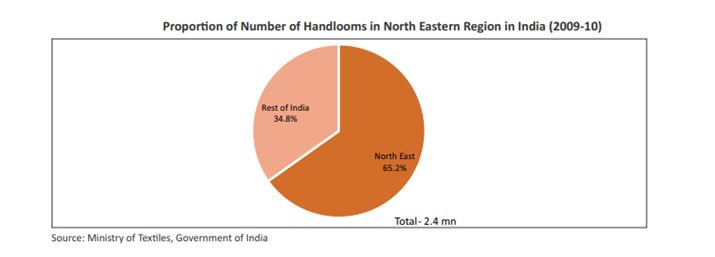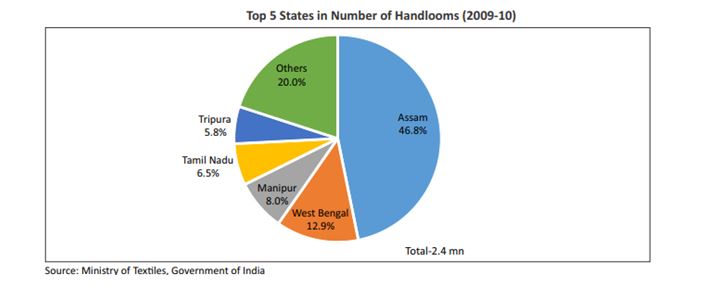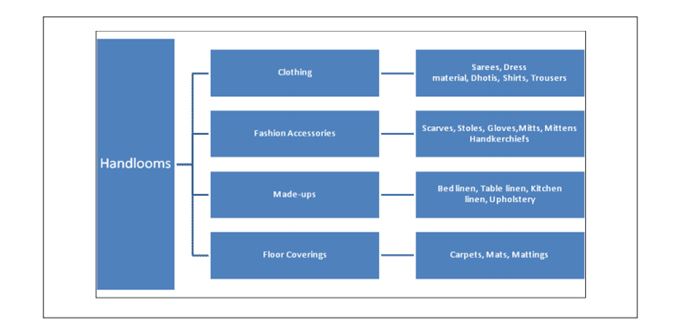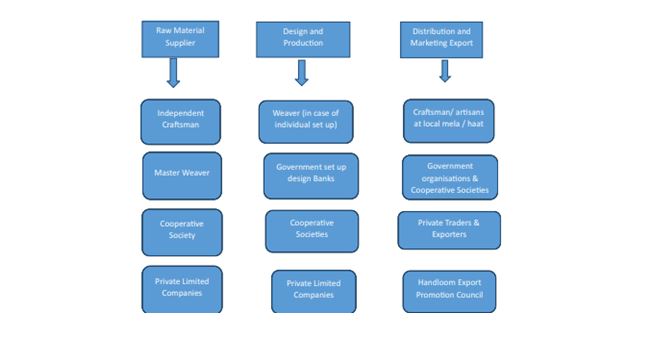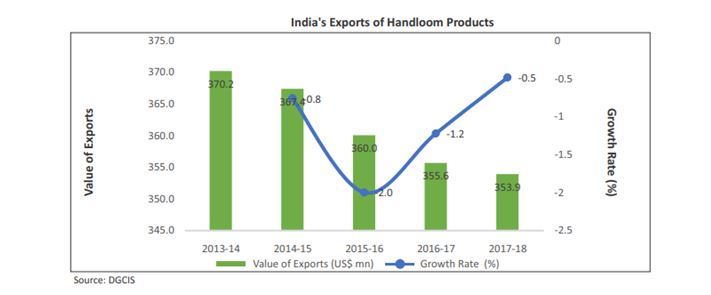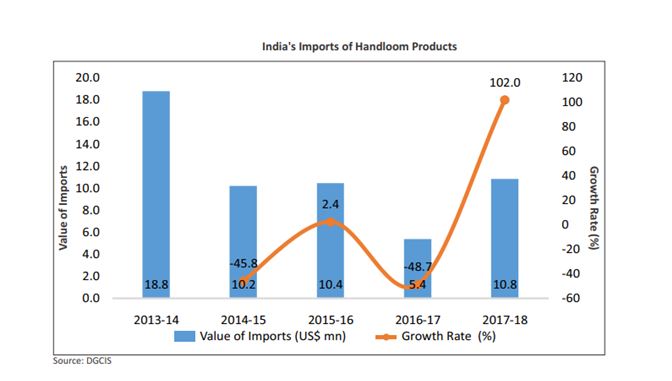Handloom Sector in India – Everything you need to know
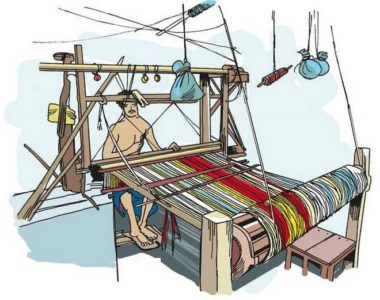
From Current Affairs Notes for UPSC » Editorials & In-depths » This topic
IAS EXPRESS Vs UPSC Prelims 2024: 85+ questions reflected
The Indian handloom industry is one of the oldest and largest cottage industries in India with a standing ancient tradition dating back thousands of years for their excellent craftsmanship, representing the vibrant Indian culture. Indian artisans dating back to the Egyptian Babylonian times had such fine mastery over their fabrics. They were appreciated globally for their hand spinning, weaving and printing techniques that were handed down from generations. Among the largest in the world, this industry employs close to 10 million artisans in India and is considered the second-largest income-generating activity after agriculture in rural India. The crisis caused by COVID-19 has resulted in a sudden disruption of all businesses across the globe including the handloom sector. The sector has severely affected by the closure of the traditional and contemporary market for artisans. Recently, India has celebrated the National Handloom Day and it was on August 7, 2020, for the first time India does so without the All India Handloom Board. The Union Ministry of Textile has abolished the All India Handloom Board in consonance with the Government of India’s vision of ‘Minimum Government and Maximum Governance’ on August 3, 2020. In this context, let’s make a detailed analysis of the Handloom Sector in India.
Indian Handloom Industry: An Overview
- Handloom is a traditional weaving craft practised by generations of artisans to create attractive textile designs.
- According to the Reservation of Articles for Production Act, 1985, the term handloom is defined as “any loom other than power loom”.
- As mentioned before, The handloom industry is one of the oldest and the largest cottage industry in India, representing and preserving the vibrant Indian culture.
- Historically handloom Industry could be found in every state of India and each region had a unique take on their handloom product.
- Due to their unique rich variety, Indian Handloom Industry had a constant high demand in the Indian market as well as all over the world for their craftsmanship and intricacy of the designs.
- Indian artists are now distinguished worldwide for their hand spinning, weaving and printing elegance.
- The strength of the handloom industry lies in the fact that it involves hardly any usage of capital and power, is eco-friendly and suitable for innovations and transformation concerning market requirements.
Concept of Handloom Industry
- The concept of handloom industry includes the process of operation by hand, of a wooden structure which is called the loom.
- The operations of this industry are primarily household-based, wherein various members of the family put in joint efforts for production.
- These activities are spread across thousands of towns and villages of the country and involve the transfer of skills from one generation to the next.
Working and Functioning of Handloom Industry
- The working and functioning in the handloom sector are entirely different from that of the power loom sector.
- Handloom weaving involves three primary motions- shedding, picking and beating.
Basis of Handloom Products
- The handloom products produced by each region vary, as each state in India specializes in a different variety of handloom product determined by the culture of that region and the skill of the workers.
- A few examples of handloom products spread across various states include Pashmina Shawls in Jammu and Kashmir, Kanchipuram Sarees in Tamil Nadu, Kutch Shawls in Gujarat and Eri and Muga silks of Assam.
Production
- The Indian textile industry is highly diversified, ranging from the traditional handwoven sector to the capital intensive mill sector.
- The various categories of cloth produced based on the process of production include the mill sector, power loom and handloom.
- The total volume of cloth produced during the year FY 2017 through these techniques was approximately 45.9 billion square meters.
- While the aggregate cloth production declined by 2.1% year-on-year, it recorded a CAGR of 1.1% during the period FY 2007 to FY 2017.
- Handloom cloth production was the second largest with a share of 17.4% in the total cloth produced, registering a CAGR of 2.0% during FY 2007 to FY 2017.
- The industry attracted Foreign Direct Investment (FDI) worth US$ 3.44 billion from April 2000 to March 2020.
Significance of Indian Handloom Industry
- The handloom industry is presently regarded as the largest economic activity in India after agriculture, generating direct as well as indirect employment for more than 3 million weaver households.
- Indian handloom created a special place for itself in India and abroad. With so many varieties of handloom from different states, India has collected a precious wealth of innovation. This has lead to the emergence of India as one of the most richly cultured country.
Characteristics of the Handloom Sector
Predominantly Rural and Unorganized Sector:
- Aforementioned, The handloom industry is primarily a rural-based economic activity with a vast majority of handloom households residing in rural areas.
- As per the third Handloom Census, there are a total of 23.77 lakh looms in the country, of which approximately 87% were being operated in the rural areas.
- Further, out of a total of 43.31 lakh persons engaged in weaving and allied activities, 84% are in rural areas.
Geographical Distribution:
- A vast majority of handlooms are located in the Northeast region of India. In terms of proportion of handlooms, 65.2% of the total handlooms in the country are being operated in the northeastern states.
- Assam is the leading state accounting for nearly 46.8% of the aggregate number of handlooms in the country.
- Other major states concerning the number of handlooms in the country are West Bengal (12.9%), Manipur (8.0%), Tamil Nadu (6.5%) and Tripura (5.8%).
Classification of Handloom Sector
1. Based on the structure and technique of working
- Handlooms are classified into four categories, namely
- Primitive Looms
- Pit Looms
- Frame Looms
- Semi-automatic Looms
2. Product Based Classification of Handloom Sector
Value Chain: Handloom Sector
- The production of handloom products involves multiple phases from the procurement of raw materials to marketing of the products.
Trade Scenario
Exports
- India was the second-largest exporter of handloom products in the world, with exports valued at US$ 353.9 million in 2017-18.
- Although there is a considerable demand globally for handloom products, India has not been able to properly position itself in the discerning international market, reflected in exports registering a consistent decline in each of the last five years between 2013-14 to 2017-18.
- The value of handloom exports stood at US$ 370.2 million in the period 2013-14, and recorded a negative CAGR of (-) 1.1% during the period 2013-14 to 2017-18.
Imports
- The imports of handloom products doubled to US$ 10.8 million during the year 2017-18 as compared to US$ 5.4 million in 2016-17.
- However, over a larger me frame, imports recorded a negative CAGR of (-) 12.9%, as the value of imports declined from US$ 18.8 million in 2013-14 to US$ 10.8 million in 2017-18.
Advantages of Handloom Sector
- The six biggest benefits of handlooms are:
1. Large premium design choices:
- Handloom enables more varieties of design to be spun out. This enables a consumer to literally own an apparel that is unique in the world and made only for him or her.
2. High ROI:
- The return on investment (ROI) on handloom is handsome.
- The cost of handloom can vary and a weaver can produce at least ₹30,000-50,000 worth fabric in a month.
3. Employment generator:
- In a country like India, where young people are looking for employment with high income, the handloom sector provides a golden opportunity to earn handsomely.
- It can enable reverse migration possibilities, from urban to rural, and reduce stress on urban infrastructure.
- It employs 10 million artisans already and can employ more.
4. GreenTech:
- Handloom is well suited to rural India, where there are power problems as it does not depend on electricity.
- It is a fine example of GreenTech.
5. Ripe for Tech disruption:
- Handloom has the opportunity to create a cab aggregator type of business model which enables matching of this disaggregated demand and supply.
6. Women empowerment:
- This is an industry which employs 83 per cent women.
- There are not many industries or corporate or government institutions that have such an inclination towards employing women.
COVID-19 and Handloom Sector
- Handloom industry is one of the oldest and most relevant Indian heritage industries, actively contributing to the rural community by providing multiple employment opportunities, thereby boosting the economy.
- The crisis caused by COVID-19 has resulted in a sudden disruption and have had a devastating impact on the handloom sector.
- Since the COVID-19 lockdown, most of the artisans have been out of work. Stocks have accumulated and they are facing a severe cash crunch.
Prime hurdles that COVID-19 has caused
- The sector has experienced sudden stalling of orders as retailers themselves are closed due to the worldwide lockdown and no signs of immediate recovery as the crisis unfolds.
- Cash flow has stopped, with buyers unable to make payments and no sales happening at all.
- Buyers are not in a position to place new orders – in the craft sector, orders are planned much as usual lead time required to complete the production cycle is 2 to 3 months.
- Retail events through which artisans get cash sales may not happen for the next few months.
- Market of the summer season when cotton handlooms sell most will be entirely lost by the time things get back to normal. This not only will create a liquidity crunch, but also severely impact their ability to invest in yarns for creating products for festive seasons (August to November) and winter, spring (October and to February) which are the other two major selling seasons for handloom textiles.
- Indian handlooms have been picking up in the ‘slow fashion’ market internationally, but with this uncertainty, no overseas orders will be forthcoming.
- Customer priorities may change with tightened budgets resulting in abrupt interruption to artisanal livelihoods.
How to help artisans tide over the crisis?
- The wide segment of artisans of clusters has a consensus in attributing their demand to a continued support from buyers and designers by placing advance orders and buying out their existing inventory of finished product rather than a request for financial assistance.
- This translates to a better margin in terms of cost efficiency for the buyers and faster cash generation for the weavers with stockpiles of finished materials.
- The artisans want to present a positive picture and the beauty of their crafts and bond with customers, offering them value in exchange for their support. So artisans are addressing the downturn due to COVID-19 by utilizing their time to improve their product catalogues, reorganize inventory and developing the online presence of their micro-enterprises.
Abolition of All India Handlooms Board and the possible implications
- As mentioned before, The Union Ministry of Textile has abolished the All India Handloom Board in consonance with the Government of India’s vision of ‘Minimum Government and Maximum Governance’ on August 3, 2020
All India Handloom Board (AIHB)
- The All India Handloom Board was set up in 1992, to advise the Government in the formulation of overall development programs in the handloom sector.
- It was also responsible for advising the Government on how to make handlooms an effective instrument for reducing unemployment and underemployment, and how to achieve higher living standards for weavers.
- The Board also formulated the development and welfare schemes of handloom weavers from time to time. Some of the welfare schemes introduced by the AIHB include:
- The Handloom Weavers Comprehensive Welfare Scheme
- National Handloom Development Program (NHDP)
- Handloom Marketing Assistance
- Weaver MUDRA Scheme
- Yarn Supply Scheme
Possible implications of the abolition of AIHB
- The role of the board has been crucial in offering subsidies, grants, and in setting up showrooms in several areas which generated sales, marketing, and training opportunities. The board was also actively involved in organizing fairs, and exhibitions to uplift the artisans. With the abolition of AIHB, there is no clarity as to what would happen to the state-level associations, and who will organize these events in the future.
- According to some commentators, the present situation has egregiously worsened with the government’s decision to abolish the All India Handlooms Board (AIHB).
- The decision to abolish AIHB will result in the systematic dismantling of the only bridge between handloom workers and the government.
- With this move, Indian textile workers lost the last platform of asserting their rights as informal sector workers and the symbolic presence of a democratic institution built to aid workers’ welfare.
- Some commentators argue that the board was closed down as a cost-cutting measure while others believe that it is a strategy to give private players a greater role in the handloom sector.
- Keeping the women workforce in this sector, More specifically a decision of this magnitude will impact women weavers more dramatically than their male counterparts.
Challenges faced by Indian Handloom Industry
1. Shortage of Raw Materials
- Despite India being the leading producer of cotton in the world, the yield in production remains low as compared to global averages and also relative to other cotton-producing countries.
2. Increase in Competition from Power Loom and Mill Sector
- The time consumed in the production of cloth when produced by handloom is substantially higher as compared to the time involved in the power looms industry. The cloth/fabric produced by the power looms industry is cheaper and the delivery is faster.
3. Lack of Credit Availability
- The two primary credit-related issues faced by handloom weavers are lack of access to credit and the expensive cost of credit.
- The cost of availing credit is exorbitant and the build-up of debts by the handloom cooperatives worsens the situation.
4. Marketing Issues
- The weavers of handloom products do not have an opportunity to receive direct feedback from customers and are unable to assess the type of demand forthcoming from the market.
- As a result, they continue to produce traditional designs without having any incentive to attempt innovation in their style of production and engage in the novelty of designs, texture and colours.
- Moreover, customers are unable to distinguish between the products produced by the handloom sector from those produced on power looms.
5. Institutional Inefficiencies
- The Primary Weavers Cooperative Societies (PWCS) have not been able to adapt themselves to the transformed scenario of the globalized world. These species face the problem of deficiency in financial robustness and ineffectiveness intensified by their unorganized nature.
6. Unorganized Nature of Industry
- The handloom sector is typically fragmented and involves numerous players, without any integration in activities.
7. Other Challenges
- Technological Backwardness
- Paucity of Novelty in Designs
- Inconvenient Working Conditions
- Insufficient Research and Training
- Inappropriate Quality of Dyes
- Lack of Information on Schemes
- Reduction in Number of Weavers
Way Forward
- Increasing Quality and Availability of Raw Materials
- Encourage Renewed Designing
- Adoption of Effective Marketing Strategies
- Creating a Niche Premium Market
- Enhancing Efficiency of PWCS
- Extension of Credit
- Infrastructural Development
- Quality Enhancement and Increased Emphasis on Packaging
- Adopt Cluster Development Approach
- Market Diversification
- Product Diversification
- Spreading Awareness
- Improve Working Conditions
- Strengthen Handloom Database
Conclusion
- The Indian handloom industry has a rich heritage that has persevered through time immemorial. Conversely, the sector is surrounded by manifold challenges such as small productivity, globalization, insufficient working capital, rapid technology development, etc. Hence, the handloom sector will have to play to its different strengths in the modern economy.
- The prudent strategy lies in bringing a balanced compromise between retaining the cultural heritage of the profession and the introduction of modern advanced technology weavers in the weaving industry.
Practice Question for MAINS
- India has some distance to cover before its artisanal goods are treated on par with counterparts abroad, but with smart policies and adequate grassroots support. Comment (250 Words)
If you like this post, please share your feedback in the comments section below so that we will upload more posts like this.
